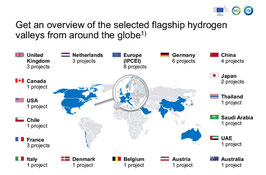South Tyrol as a global hyrogen model region
"Mission Innovation" (Ministers for Economics of Europe, China, Australia, the USA and several South American countries) and the FCH-JU have chosen 40 projects all over the world which have one common goal: promoting hydrogen as a sustainable link between energy and mobility. These flagship projects are now being monitored more closely in order to gain valuable insights for other countries and projects. The Hydrogen Valley South Tyrol is one of these selected projects.
President Arno Kompatscher underlines: ““The timing fits in perfectly with our programs: The Corona crisis is putting all sectors of the local economy and every one of us to the test. A new beginning must follow from this crisis, both here and worldwide, which must be as sustainable as possible right from the start. And hydrogen, I'm convinced, will play an important role in this.”
A "Hydrogen Valley" in three steps
The South Tyrolean Hydrogen Valley consists of 3 expansion stages: The first step were the successful EU pilot projects "CHIC" and "HyFIVE" in the field of
electric fuel cell buses and cars. Now, South Tyrol is currently in phase 2 with the regional roll-out being realized thanks to the projects "Mehrlin, "JIVE" and
"LIFEalps", which are supported by the South Tyrolean Provincial Government and the EU. This means that the infrastructures will be expanded and that several fleets of zero emission vehicles will
be put on the roads to boost emission-free services in various sectors, e.g. local public transport or tourism.
"It is important that regional development is coordinated and strategic. Therefore, a hydrogen plan for South Tyrol and, in close cooperation with the neighbouring provinces, for the entire
Euregio is currently being developed, which will build on the South Tyrolean experience of the past years," adds Provincial Councillor for Mobility Daniel Alfreider.
Regional expansion is followed by supraregional and international expansion in the third and final phase. And this is where South Tyrol's geographical location plays an essential role: the Brenner corridor connects Central Europe with Italy and suffers by a particularly strong (heavy traffic) congestion. The goal of phase 3, in which the Brenner Motorway Ltd. will also play an important role, is to relieve this burden and make it as emission-free as possible: "Contrary to what many people think, it is not the motorway that pollutes the environment, but the vehicles. What a motorway, on the other hand, can do, and what we have already done and will continue to do, is to promote zero-emission mobility and we aim at making the Brenner corridor the first green corridor in Europe. We expect a lot from the trucks in particular," adds Carlo Costa, Technical Director General of Brenner Motorway.
The project's strengths
The concept for the "Hydrogen Valley South Tyrol" was developed by the Institute for Innovative Technologies (IIT) in cooperation with the Brenner Motorway and Alperia - which means that an important domestic energy supplier is also on board: "We want to bring renewable energy for all forms of electro-mobility and all vehicle categories onto the road, and will therefore continue and increase our commitment to hydrogen," says Johann Wohlfahrter, General Director of Alperia.
It was precisely this close alliance between local politicians, motorway operators and the local energy industry in a coherent and long-term concept that was one of the criteria that led to the
project from "little South Tyrol" now being selected as a model and know-how supplier worldwide.

The "Hydrogen Valley South Tyrol" was presented as part of Mission Innovation 2019 in Antwerp (picture shows the participants): The Ministry for Economic Development (MISE) had invited the IIT to represent Italy there.
Further information: official Hydrogen Valleys homepage





